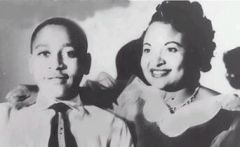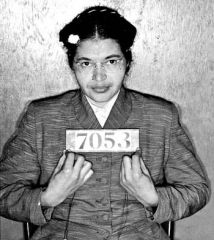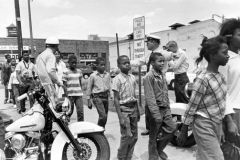![]()
![]()
![]()
Use LEFT and RIGHT arrow keys to navigate between flashcards;
Use UP and DOWN arrow keys to flip the card;
H to show hint;
A reads text to speech;
43 Cards in this Set
- Front
- Back
|
Plessy v Ferguson
|
On June 7, 1892, 30-year-old Homer Plessy was jailed for sitting in the "White" car of the East Louisiana Railroad. Plessy could easily pass for white but under Louisiana law, he was considered black despite his light complexion and therefore required to sit in the "Colored" car. His court case went directly into the supreme court. The Plessy decision set the precedent that "separate" facilities for blacks and whites were constitutional as long as they were "equal."
|
|
|
segregation, jim crow
|
Jim Crow laws were used to enforce segregation
Jim Crow represented the legitimization of anti-black racism. |
|
|
separate but equal
|
The Plessy decision set the precedent that "separate" facilities for blacks and whites were constitutional as long as they were "equal."
|
|
|
integration/desegregation
|
Desegregation is the lifting of the legal restrictions which limited the exercise of full civil liberties for minorities.
Integration would be the mixing of the races and ideally, the ignoring of any racial distinctions. The Montclair School district is integrated. |
|
|
tactics of the movement
|
"equalization strategy," lawsuits were filed demanding that the facilities provided for black students be made equal to those available to white students, carefully stopping short of a direct challenge to Plessy.
|
|
|
NAACP
|
National Association for the Advancement of Colored People is to ensure the political, educational, social, and economic equality of rights of African Americans
|
|
|
Brown v. Board of Education
|
Black children were denied admission to public schools attended by white children under laws requiring or permitting segregation according to the races.
Despite the equalization of the schools by "objective" factors, intangible issues foster and maintain inequality. Racial segregation in public education has a detrimental effect on minority children because it is interpreted as a sign of inferiority. The long-held doctrine that separate facilities were permissible provided they were equal was rejected. Separate but equal is inherently unequal in the context of public education. |
|
|
murder of Emmett Till, Mose Wright
|

When, on December 1, 1955, Rosa Parks refused to obey an order to give up her seat on a Montgomery bus to a white person, an action that led to a boycott of the Montgomery bus system, she had in mind a murder trial that happened two months earlier in Sumner, Mississippi. A fourteen-year-old boy, Emmett Till, had been brutally murdered and his body thrown in the Tallahatchie River, but despite clear evidence that two white men committed the crime, an all-white jury returned a "Not Guilty" verdict after just an hour of deliberation. Parks wrote, "the news of Emmett's death caused me...to participate in the cry for justice and equal rights."
|
|
|
Martin Luther King, JR.
|
an American clergyman, activist, and leader in the African-American Civil Rights Movement.
|
|
|
Rosa Parks, Montgomery bus boycott
|

Rosa Parks, a seamstress, rode at the front of a Montgomery, Alabama, bus on the day the Supreme Court's ban on segregation of the city's buses took effect.
The Montgomery Bus Boycott, a seminal event in the U.S. civil rights movement, was a political and social protest campaign against the policy of racial segregation on the public transit system of Montgomery, Alabama. |
|
|
Nonviolence
|
MLK JR. issued principles of nonviolence. He felt nonviolence is a way of life for courageous people which seeks to win friendship and understanding. Nonviolence seeks to defeat injustice, not people. MLK JR thought that voluntary suffering can educate and transform. Nonviolence chooses love instead of hate.
|
|
|
SCLC
|
The Southern Christian Leadership Conference (SCLC) is an African-American civil rights organization.
With the goal of redeeming ''the soul of America'' through nonviolent resistance |
|
|
Little Rock, Central HS, Orval Faubus
|
Orval Faubus 36th Governor of Arkansas, serving from 1955 to 1967
He is best known for his 1957 stand against the desegregation of the Little Rock School District during the Little Rock Crisis, in which he defied a unanimous decision of the United States Supreme Court by ordering the Arkansas National Guard to stop African-American students from attending Little Rock Central High School. |
|
|
lunch counters, sit-ins
|
The basic plan of the sit-ins was that a group of students would go to a lunch counter and ask to be served. If they were, they'd move on to the next lunch counter. If they were not, they would not move until they had been. If they were arrested, a new group would take their place. The students always remained nonviolent and respectful.
|
|
|
SNCC
|
The Student Nonviolent Coordinating Committee (SNCC) was one of the organizations of the American Civil Rights Movement in the 1960s.
It demonstrated that ordinary black women and men, young and old, could perform extraordinary tasks. |
|
|
CORE
|
The Congress of Racial Equality
interracial group of students seeking to change racist attitudes. They were interested in nonviolent resistance |
|
|
Freedom Rides
|
Freedom Riders were civil rights activists who rode interstate buses into the segregated southern United States in 1961 and following years to challenge the non-enforcement of the United States Supreme Court decisions which ruled that segregated public buses were unconstitutional. The Southern states had ignored the rulings and the federal government did nothing to enforce them.
|
|
|
Ole Miss, james meredith, Ross Barnett
|
Ross Robert Barnett was the governor of Mississippi from 1960 to 1964. He was a States' Rights Democrat, as well as one of many Democrats who supported segregation.
--Barnett arranged for the arrest of Freedom Riders in 1961 --Barnett opposed Black Student James Meredith's efforts to enroll in his alma mater University of Mississippi. --riots occurred at Ole Mississippi protesting Meredith's admission |
|
|
Birmingham, children's march, Bul Connor,
|

Charles Avery left his high school in Jefferson County, Alabama, to lead about 800 of his fellow students on a 10-mile walk to Birmingham City. They were stopped by the sheriff’s department, arrested, and jailed. “I was put in the paddy wagon"
The next day, the police, led by infamous commissioner of public safety Bull Connor, brought out fire hoses and attack dogs and turned them on the children. It was a scene that caused headlines across the nation and around the world. |
|
|
Letter from Birmingham Jail
|
he Letter from Birmingham Jail (also known as "Letter from Birmingham City Jail" and "The Negro Is Your Brother") is an open letter written on April 16, 1963, by Martin Luther King, Jr.
|
|
|
16th St. Baptist Church
|
In September 1963, it was the target of the racially motivated 16th Street Baptist Church bombing that killed four girls in the midst of the American Civil Rights Movement.
members of the KKK planted 19 sticks of dynamite outside of the basement of the church. at 10 the next morning they exploded killing four young girls. They were preparing for the church's "Youth Day" |
|
|
Medgar Evers
|
an African-American civil rights activist from Mississippi involved in efforts to overturn segregation at the University of Mississippi. After returning from overseas military service in World War II and completing his secondary education, he became active in the civil rights movement. Evers was assassinated by Byron De La Beckwith, a member of the White Citizens' Council. His murder helped spur the civil rights movement.
|
|
|
Freedom Summer, MFDP, Fannie Lou Hamer
|
MFDP: Mississippi Freedom Democratic Party
Black voting rights Poor and black, Fannie Hamer picked cotton her whole life since she was six. When she was older she learned she could vote. She took a bus to register to vote. She was pressured not to vote by her boss. She quit and became active in a movement to register blacks to vote. She said, "I'm sick and tired of being sick and tired." She was arrested and beaten when trying to dine at an all white restaurant. MLK JR helped secure her release from jail. Freedom summer helped teach basic skills and teach people how to pass the test to vote. To help oppose segregated Mississippi they established the MFDP. Hamer felt that black voting rights were the heart of the civil rights struggle. |
|
|
DNC 1964, murders of goodman, cheney, schwerner
|
volunteers who were helping the MFDP
2 white, one black. They were murdered while investigating a church bombing. |
|
|
role of KKK and citizen's councils
|
The White Citizens' Council (WCC) was an American white supremacist organization formed on July 11, 1954.
the group was well known for its opposition to racial integration during the 1950s and 1960s, when it retaliated with economic boycotts and other strong intimidation against black activists, including depriving them of jobs. |
|
|
role of music/songs
|
Music and singing played a critical role in inspiring, mobilizing, and giving voice to the civil rights movement.
|
|
|
March on washington 1963, I have a dream
|
The March on Washington for Jobs and Freedom
one of the largest political rallies for human rights in United States history[3] and called for civil and economic rights for African Americans. It took place in Washington, D.C. on Wednesday, August 28, 1963. Martin Luther King, Jr., standing in front of the Lincoln Memorial, delivered his historic "I Have a Dream" speech advocating racial harmony during the march.[4] |
|
|
Civil Rights Act 1964, Voting rights act 1965, 24th amendment
|
After the Civil War ended, many blacks tried to vote. They were often met with violence, and many of those who felt threatened by blacks set up restrictions to keep the former slaves from voting. Since most blacks could not read or write, literacy tests were established. High poll taxes were also imposed. When whites could not read, write, or afford to pay the taxes, they were still allowed to vote.
In 1964, poll taxes were abolished by the 24th Amendment to the U.S. Constitution. Another advancement came when the Voting Rights Act of 1965 became law on August 6, 1965. Its provisions outlawed the literacy tests and made it easier for African Americans to vote. |
|
|
selma, bloody sunday
|
In 1965, at the height of the modern civil rights movement, activists organized a march for voting rights, from Selma, Alabama, to Montgomery, the state capital.
One minute and five seconds after a two-minute warning was announced, the troops advanced, wielding clubs, bullwhips, and tear gas. John Lewis, who suffered a skull fracture, was one of fifty-eight people treated for injuries at the local hospital. The day is remembered in history as “Bloody Sunday.” |
|
|
murder of viola liuzzo
|
39 year old mother Liuzzo was horrified by the images of "Bloody Sunday." Nine days later, she took part in a protest at Wayne State. She then called her husband to tell him she would be traveling to Selma, saying that the struggle "was everybody's fight." Klan members pulled up alongside liuzzo's car and shot directly at her killing her. MLK Jr. attended her funeral. One of the shooters was an FBI informant. Many civil rights activists believe that Liuzzo's death helped with the passing of the 1965 voting rights act.
|
|
|
malcom x
|
an African-American Muslim minister and human rights activist.
To his admirers, he was a courageous advocate for the rights of blacks, a man who indicted white America in the harshest terms for its crimes against black Americans. Detractors accused him of preaching racism, black supremacy, and violence. |
|
|
separatism
|
the advocacy of a state of cultural, ethnic, tribal, religious, racial, governmental or gender separation from the larger group.
|
|
|
black power and its meaning, stokely carmichael
|
stokely carmichael - civil rights black activist
Honorary prime minister of the black panther party black power urged black pride It is a call for black people in this country to unite, to recognize their heritage, to build a sense of community. It is a call for black people to define their own goals, to lead their own organizations. |
|
|
Kerrenga, Kwanzaa
|
Karenga created Kwanzaa in 1966[11] to be the first pan-African holiday. He said his goal was to "give Blacks an alternative to the existing holiday and give Blacks an opportunity to celebrate themselves and their history, rather than simply imitate the practice of the dominant society.
|
|
|
pan-Africanism
|
an ideology and movement that encourages the solidarity of Africans worldwide. It is based on the belief that unity is vital to economic, social, and political progress and aims to “unify and uplift” people of African descent.
|
|
|
Black Panthers, Huey Newton, Bobby Seale, Eldridge Cleaver
|
followers of Malcolm X's practices, Huey Newton and Bobby Seale founded the Black Panther Party for Self-Defense. The Panthers practiced militant self-defense of minority communities against the U.S. government, and fought to establish revolutionary socialism through mass organizing and community based programs.
Military, dignity vs the nonviolence of MLK. (the black panthers were pretty scary--mom) |
|
|
de facto vs. de jure
|
--de jure segregation is segregation enforced by law
--de facto segregation is segregation enforced by society through habits. |
|
|
militancy
|
Having a combative character; aggressive, especially in the service of a cause: a militant political activist.
--black panthers |
|
|
urban "riots" (watts, newark, detroit)
urban life, causes and effects of riots |
The summer of 1967 marked the apex of a cycle of 'urban unrest' -- riots in Detroit, Newark and watts were particularly dramatic with the national guard being send in with guns.
The facts of racial segregation and intense poverty and restricted opportunities for African-Americans created an environment where urban African-American youth had seething grievances and a sense of little to lose; a dilapidated and depressing housing stock reinforced this sense of isolation, anger, and hopelessness; |
|
|
assassination of Malcolm X
|
February 21, 1965, New York City, NY
He was assassinated by rival Black Muslims, the nation of islam. |
|
|
assassination of MLK
|
April 4, 1968, Memphis, TN
Hit by a sniper on a balcony he was standing in front of his room. Escaped convict James Earl Ray was arressted but many people believe he was innocent. Many felt that the FBI had something to do with it. |
|
|
issues related to mass incarceration
|
Among all African American men born since the mid-1960s, more than 20 percent will go to prison, nearly twice the number that will graduate college. This extraordinary pattern of penal confinement has been called “mass incarceration,” a rate of incarceration so high that it affects not only the individual offender, but also whole social groups.
|
|
|
issues related to the racial wealth gap
|
Many Americans still believe that racial inequality is related to individual behavior, choices, character, marriage and child bearing but no...
HOMEOWNDERSHIP has been the biggest cause of racial wealth disparity, followed by INCOME, the study found. In the past 25 years, education has failed to be the great equalizer that many expected. |

